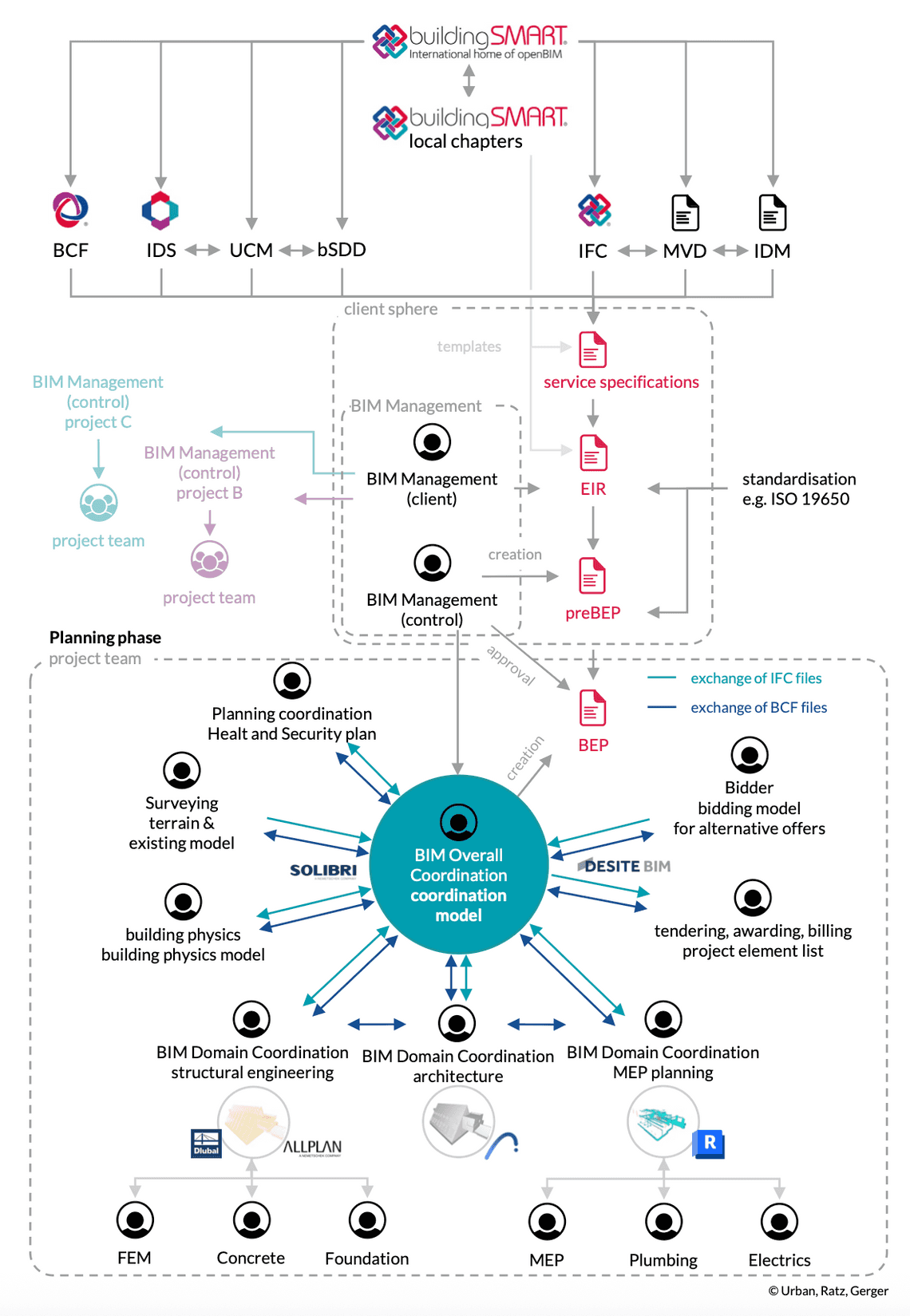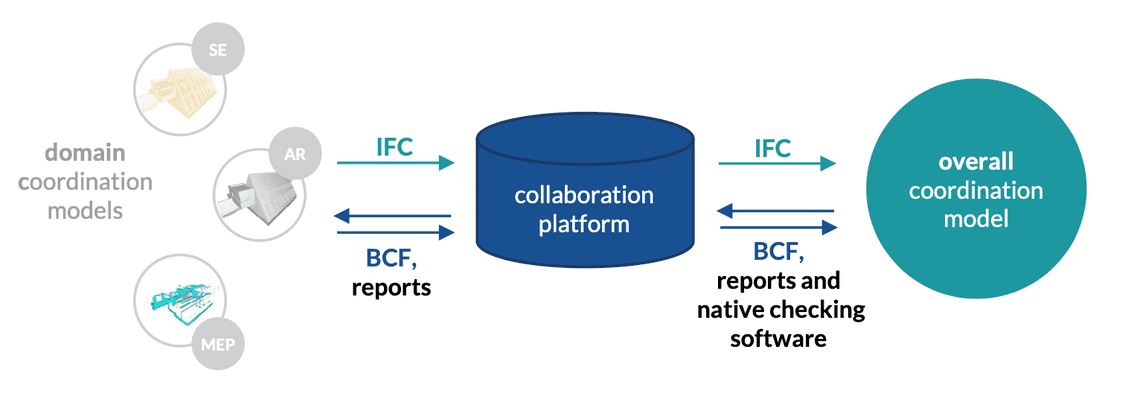Table des matières
In the previous articles we’ve now explored openBIM from the inside out — from the IFC Schema and its properties and relationships, to the supporting standards MVD, IDS, bSDD, and CDE. 🏗️💡
Now we turn to the practical side: 👉 How does openBIM actually work in real projects?
The implementation of openBIM is not only about exporting an IFC file. It’s about managing interoperability, collaboration, and information exchange across the entire project lifecycle — ensuring that data stays reliable from design to facility management.
From Closed to Open BIM Workflows
Traditional (“closed”) BIM workflows lock teams inside one vendor’s ecosystem. Everyone uses the same software, and coordination is restricted to that environment. 🔓
openBIM workflows, in contrast, enable:
- Interoperability between tools like Revit, Archicad, Tekla, Allplan, etc.
- Cross-disciplinary collaboration among architects, structural, and MEP engineers.
- Data transparency through shared open standards.
👉 In short: openBIM removes vendor lock-in and promotes open data exchange based on the IFC format.

OpenBIM Across the Project Lifecycle
OpenBIM supports all phases of a construction project — from concept design to operation. Each stage uses specific IFC workflows and BIM coordination standards: 🕰️
| Project Phase | Typical openBIM Deliverables | Key Standards / Tools |
|---|---|---|
| Planning | Concept models, design intent | IFC, MVD (Design Transfer View) |
| Design | Detailed coordination, clash detection | IFC, BCF, Coordination View |
| Construction | Fabrication, quantity take-off | IFC + bSDD + IDS |
| Operation | Asset management, digital twin | IFC + FM Handover View + CDE |
| Renovation | As-built model updates | IFC (Reference View) |
At each phase, IFC models are refined, validated with IDS, and enriched with bSDD-based property templates to ensure consistency.
Interdisciplinary Collaboration in openBIM
The essence of openBIM lies in collaboration. Different disciplines contribute their models to a shared Common Data Environment (CDE) using IFC as a universal language. 🧱⚙️🌬️
Architecture
Architects establish the spatial hierarchy — buildings, storeys, and spaces — and export design models containing: 🧱
- IfcWall, IfcDoor, IfcWindow, IfcSpace, etc.
- Property sets like Pset_WallCommon, Pset_SpaceCommon.
- MVDs such as Design Transfer View or Reference View.
Structure
Structural engineers import the architectural IFC and generate an analytical model: ⚙️
- Convert IfcWall or IfcSlab to structural elements.
- Add loads, materials, and reinforcement.
- Export updated geometry and properties for coordination.
MEP 🌬️
- Mechanical, electrical, and plumbing models use IFC entities such as IfcFlowSegment and IfcDistributionSystem.
- They rely heavily on accurate spatial placement and consistent property definitions, validated by IDS and linked to bSDD terms.
Facility Management 🏢
- When the project is complete, the same IFC data continues to serve as the foundation for digital twins and maintenance systems.
- Entities like IfcAsset, IfcZone, and IfcTypeProduct ensure data continuity throughout the building’s life.
Communication and BIM Coordination
Effective communication is the backbone of every openBIM workflow. Two key standards ensure that issues and changes are tracked transparently: 💬
- BCF (BIM Collaboration Format) — a lightweight XML format for exchanging comments, viewpoints, and tasks between BIM tools.
- CDE platforms — such as BIMcollab, Trimble Connect, or Autodesk Construction Cloud, hosting IFC and BCF together for full traceability.
👉 Instead of screenshots and emails, teams use structured issue management directly linked to IFC elements.

Quality Control and Model Validation
An openBIM workflow must include data quality assurance. Automated validation using IDS (Information Delivery Specification) ensures that every IFC model meets project requirements. ✅
Typical validation checks include:
- Are all required entities present?
- Are mandatory properties (e.g. FireRating, U-Value) filled in?
- Are classification codes aligned with the buildingSMART Data Dictionary (bSDD)?
Tools like Solibri, BIMcollab Zoom, and DesiteMD automate this process.
The Role of the Common Data Environment (CDE)
The CDE serves as the central hub for all openBIM data. It manages access, revisions, and validation across multiple disciplines and IFC models. ☁️
Core CDE functions:
- Version control and approval workflows.
- Role-based access and permissions.
- Model federation (combining several IFCs into one coordinated model).
- Integration with IDS and bSDD for live checks.
A well-structured CDE ensures that IFC workflows remain traceable, verifiable, and collaborative throughout the project.
Lessons from Real-World openBIM Projects
Experience from projects in the private and public sector shows that successful openBIM implementation requires: 🧭
- Early agreement on MVDs, property templates, and IDS requirements.
- Software certified for buildingSMART IFC export/import.
- Consistent CDE governance for model sharing.
- Documented custom properties and clear naming rules.
Despite ongoing challenges — file size, geometry interpretation, inconsistent attributes — openBIM consistently improves interoperability and data transparency across the AEC industry.
The Future of openBIM: Towards IFC 5 and Linked Data
OpenBIM isn’t standing still. As the construction industry embraces digital transformation, new technologies are reshaping how we model, validate, and connect information. 🌐🚀
🔗 IFC 5 — Beyond File-Based Exchange
The next version, IFC 5, aims to move from static file transfers to continuous data exchange via APIs and databases. Instead of sending .ifc files, teams will synchronise models directly through cloud-based openBIM workflows.
🧠 Semantic Web and Linked Data
The integration of semantic web technologies (RDF, OWL) allows IFC entities and properties to be linked to global knowledge graphs.
This means:
- Buildings become part of the web of data.
- IFC objects can reference external classifications, IoT sensors, and product libraries.
- Queries like “show me all fire-rated walls on level 2” become real-time and cross-platform.
🌱 Sustainability and Digital Twins
OpenBIM is also merging with environmental performance tools and digital twin platforms. IFC-based models enriched with bSDD properties and sensor data support lifecycle analysis, energy management, and predictive maintenance — all built on the same open foundation.
👉 The next chapter of openBIM will not just describe buildings — it will connect them.
Conclusion: The Promise — and Paradox — of openBIM
OpenBIM has come a long way. What began as an ambitious idea — seamless collaboration through shared data standards — is now a tangible, working ecosystem. 🏁
Through IFC workflows, CDE platforms, and specifications like MVD, IDS, and bSDD, it’s possible today for architects, engineers, and facility managers to exchange structured information beyond software boundaries. That’s no small achievement.
But let’s be honest: openBIM is still harder than it should be. Every promise of interoperability comes with a new layer of complexity — file sizes, model coordination, version mismatches, naming inconsistencies, unpredictable geometry behaviour. We’ve traded vendor lock-in for a labyrinth of standards, validation tools, and checklists that require expertise most teams don’t yet have.
OpenBIM is also only as good as its implementation. Many projects still treat IFC export as an afterthought — a button pressed at the end of design, not a workflow integrated from the start. And while CDEs are supposed to connect everything, in practice they often become just another silo — cloud-based this time.
Still, it’s worth the effort. The potential of openBIM is enormous:
- Transparent, vendor-neutral collaboration.
- Data longevity far beyond the lifespan of proprietary software.
- The foundation for digital twins, sustainability analytics, and lifecycle asset management.
The next frontier — IFC 5, Linked Data, and semantic integration �— could finally make BIM what it was meant to be: not a set of disconnected files, but a living web of building knowledge.
Yet getting there will require something more than new standards:
- Better education for practitioners.
- Stricter implementation guidelines.
- Smarter tools that make openBIM feel less like a research project and more like everyday work.
OpenBIM has proven that collaboration is possible. Now it must prove that it can be practical. The future of digital construction depends on it — and perhaps, that’s exactly what makes the effort worthwhile.
